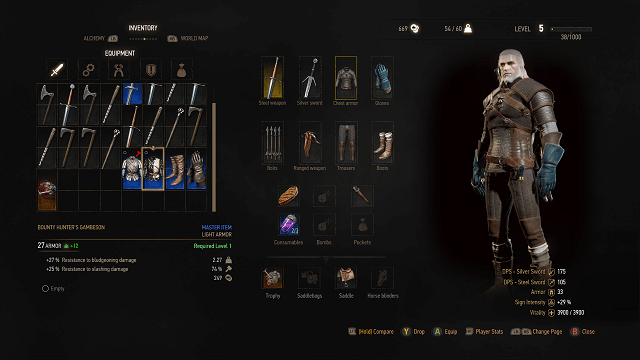The Witcher 3: Wild Hunt has two main weapon types, Steel Sword and Silver Sword. They are both used for different things and have upgrades you can use. There are also other weapons you can use that don’t fall into these categories.
I’ll explain how weapons work in this game as well as let you know of the upgrades options you have. For help with anything else related to the game, check out the Master Guide List.
This guide will cover weapons and upgrades in The Witcher 3 including:
- Weapon Types – All the types of weapons you can use in the game and explanations on when to use each.
- Weapon Upgrades – The types of upgrades you can use on your weapons.
- Armor Types – All the types of armor you can use in the game and what the different types mean.
- Armor Upgrades – The types of upgrades you can use on your armor.
Weapon Types
- Steel Sword – This weapon is used mostly for humans and non-magical creatures.
- To make thing easier, use this on enemies with Red health bars.
- Silver Sword – This weapon is used on creatures and monsters.
- Use on enemies with White health bars.
- Crossbow – Ranged weapon that is great for keeping distance, staggering, and knocking enemies out of the air.
- These use bolts to attack.
- Melee Weapons – Besides the steel and silver swords, you can get other weapons, such as axes or maces.
Weapon Upgrades

Weapons can have bonuses on them even before you upgrade. Below are a few examples of bonus that weapons can have on them.
- Bonus experience when killing
- Sign intensity
- Chance to bleed
- Adrenaline gain
- Attack power
- Armor piercing
Check the bonuses of weapons before deciding if you should upgrade them.
Runestones
Some swords have sockets, this allows you to add a runestone to upgrade them. There are several types of runestones, which can add anything from increased sign intensity to a poison damage to your weapon. Check out the Runestone guide for full details on all the possible runestones and diagrams to craft them.
Armor Types
You can equip armor to 4 slots, chest, gloves, trousers, and boots. Armor in The Witcher 3 comes in 3 types:
- Light
- Medium
- Heavy
These armor types have different defense values depending on type, but there is also something important to know about them. There are 3 general skills that affect what each armor types does.
- Cat School Techniques – Each piece of light armor increases critical hit damage by 25% and fast attack damage by 5%.
- Griffin School Techniques – Each piece of medium armor increases Sign intensity by 5% and Stamina regeneration by 5%.
- Bear School Techniques – Each piece of heavy armor increases maximum Vitality by 5% and strong attack damage by 5%.
This changes what you look for in armor. If you like to use Signs a lot, like me, investing in the Griffin School Techniques skill is a good idea. Then, try to get medium armor for all 4 pieces to get an increase of 25% in Sign intensity and Stamina regeneration.
On the other hand, you can get a 100% increase to critical damage and 25% increase to fast attack damage by getting the Cat School Techniques skill and equipping full light armor.
You can get 2 or all 3 of them if you wish, but with limited skill slots, you probably should not do that.
Armor Upgrades
Armor can also have bonuses on them. They give things like resistances to certain damage types, sign intensity, and attack power.
Glyphs

Armor can also have sockets. Instead of runestones, armor uses glyphs. These increase Sign intensity of one of the 5 Signs in the game. Check out the Glyphs guide for the full list and how to craft them.
That’s it for my Weapons, Armor, and Upgrades Basics for The Witcher 3: Wild Hunt. Please visit by Beginner’s Guide for more tips and help on the game.







Published: May 27, 2015 11:45 AM UTC